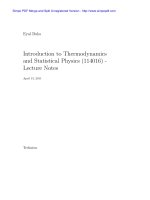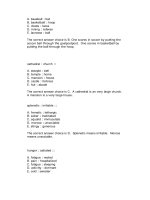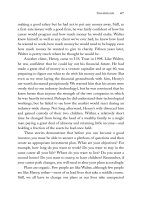Introduction to Thermodynamics and Statistical Physics phần 4 ppt
Bạn đang xem bản rút gọn của tài liệu. Xem và tải ngay bản đầy đủ của tài liệu tại đây (313.67 KB, 17 trang )
2. Ideal Gas
In this chapter w e study some basic properties of ideal gas of massive iden-
tical particles. We start by considering a single partic le in a box. We then
discuss the statistical pro perties of an ensemble of identical indistinguishable
particles and introduce the concepts of Fermions and Bosons. In the rest of
this chapter we mainly focus on the classical limit. For this case we derive
expressions for the pressure, heat capacity, energy an d entropy and discuss
how internal degrees of freedom may modify these results. In the last part
of this chapter we discuss an example of an heat engine based on ideal gas
(Carnot heat e ngine). We show t hat t he efficiency of such a heat engine,
which employs a reversible process, obtains the largest possible value th at is
allowed by the second law of ther mod ynamics.
2.1 A Particle in a Box
Consider a particle having mass M in a box. For simplicity the b ox is assumed
to have a cube shape with a volume V = L
3
. The corresponding potential
energy is given by
V (x, y, z)=
½
00≤ x, y, z ≤ L
∞ else
. (2.1)
The quantum eigenstates and eigenenergies are determ ined by requiring that
the wav efunction ψ (x, y, z)satisfies the Schr¨odinger equation
−
~
2
2M
µ
∂
2
ψ
∂x
2
+
∂
2
ψ
∂y
2
+
∂
2
ψ
∂z
2
¶
+ Vψ= Eψ . (2.2)
In addition, we require that the wa vefunction ψ vanishes on the surfaces of
the bo x. The normalized s olutions are given by
ψ
n
x
,n
y
,n
z
(x, y, z)=
µ
2
L
¶
3/2
sin
n
x
πx
L
sin
n
y
πy
L
sin
n
z
πz
L
, (2.3)
where
n
x
,n
y
,n
z
=1, 2, 3, (2.4)
Chapter 2. Ideal Gas
The corresponding eigenenerg ies are given by
ε
n
x
,n
y
,n
z
=
~
2
2M
³
π
L
´
2
¡
n
2
x
+ n
2
y
+ n
2
z
¢
. (2.5)
For simplicity we consider the case where the particle doe sn’t hav e any in-
ternal degree of freedom (such as spin). Later we will release this assumption
and generalize the results for particles having internal degrees of freedom.
The partition function is given by
Z
1
=
∞
X
n
x
=1
∞
X
n
y
=1
∞
X
n
z
=1
exp
³
−
ε
n
x
,n
y
,n
z
τ
´
=
∞
X
n
x
=1
∞
X
n
y
=1
∞
X
n
z
=1
exp
¡
−α
2
¡
n
2
x
+ n
2
y
+ n
2
z
¢¢
,
(2.6)
where
α
2
=
~
2
π
2
2ML
2
τ
. (2.7)
The follo wing relation can be employed to e stimate the dimensionless param -
eter α
α
2
=
7.9 × 10
−17
M
m
p
¡
L
cm
¢
2
τ
300 K
, (2.8)
where m
p
is the proton mass. As can be seen from the last r esult, it is often
the case that α
2
¿ 1. In this limit the sum can be approximated by an
integral
∞
X
n
x
=1
exp
¡
−α
2
n
2
x
¢
'
∞
Z
0
exp
¡
−α
2
n
2
x
¢
dn
x
. (2.9)
By changing the integration variable x = αn
x
one finds
∞
Z
0
exp
¡
−α
2
n
2
x
¢
dn
x
=
1
α
∞
Z
0
exp
¡
−x
2
¢
dx =
√
π
2α
, (2.10)
thus
Z
1
=
µ
√
π
2α
¶
3
=
µ
ML
2
τ
2π~
2
¶
3/2
= n
Q
V, (2.11)
where we have introduced the quantum density
Eyal Buks Thermodynamics and Statistical Physics 46
2.1. A Particle in a Box
n
Q
=
µ
Mτ
2π~
2
¶
3/2
. (2.12)
The par tition function (2.11) together with Eq. (1.70) allows evaluating
the average energy (recall that β =1/τ )
hεi = −
∂ log Z
1
∂β
= −
∂ log
µ
³
ML
2
2π~
2
β
´
3/2
¶
∂β
= −
∂ log β
−3/2
∂β
=
3
2
∂ log β
∂β
=
3τ
2
.
(2.13)
This result can be written as
hεi = d
τ
2
, (2.14)
where d = 3 is the number of degrees of freedom of the pa rticle. As we will see
later, this is an example of the equipartition theorem of statistical m echanics.
Similarly, the energy va riance can be evaluated using Eq . (1.71)
D
(∆ε)
2
E
=
∂
2
log Z
1
∂β
2
= −
∂ hεi
∂β
= −
∂
∂β
3
2β
=
3
2β
2
=
3τ
2
2
.
(2.15)
Thus, using Eq. (2.13) the standard de viation is given by
r
D
(∆ε)
2
E
=
r
2
3
hεi . (2.16)
What is the physical meaning of the quantum density? The de Broglie
wavelength λ of a particle having mass M and velocity v is giv en by
Eyal Buks Thermodynamics and Statistical Physics 47
Chapter 2. Ideal Gas
λ =
h
Mv
. (2.17)
For a particle having energy equals to the average energy hεi =3τ/2 one has
Mv
2
2
=
3τ
2
, (2.18)
thus in this case the de-Broglie wavelength, w hich is denoted as λ
T
(the
thermal waveleng th)
λ
T
=
h
√
3Mτ
, (2.19)
and therefore one has (recall that ~ = h/2π)
n
Q
=
Ã
π
h
2
2Mτ
!
3/2
=
Ã
1
λ
T
r
2π
3
!
3
. (2.20)
Thus the quantum density is inversely proportional to the thermal wavelength
cubed.
2.2 Gibbs Paradox
In the previous section we have studied the case of a single particle. Let us
now consider the case where t he box is occupied b y N particles of the same
t ype. For simplicity, we consider the case where the density n = N/V is
sufficiently small to safely allowing to neglect any interactio n between the
particles. In this case the gas is said to be ideal.
Definition 2.2.1. Idea l gas is an ensemble of non-interacting identical par-
ticles.
What is the partition function of the ideal gas? Recall that for the single
particle case we have found that the par t ition function is giv en by [see Eq.
(2.6)]
Z
1
=
X
n
exp (−βε
n
) . (2.21)
In this expression Z
1
is obtained by summing over a ll single particle orbital
states, w hich are d e noted by the vector of quan tum num bers n =(n
x
,n
y
,n
z
).
These states are called orbitals .
Since the total num ber of particles N is constrained we need to calculate
the canonical partition function. For the case of distinguishable particles one
may argue that the canonical partition function is given by
Eyal Buks Thermodynamics and Statistical Physics 48
2.2. Gibbs Paradox
Z
c
?
= Z
N
1
=
Ã
X
n
exp (−βε
n
)
!
N
. (2.22)
However, as was demonstrated by Gibbs in his famous paradox, this answer
is wrong. To see this, we employ Eqs. (1.72) and (2.11) and assume that the
partition function is given by Eq. (2.22) above, thus
σ −βU =logZ
c
?
=logZ
N
1
= N log (n
Q
V ) , (2.23)
orintermsofthegasdensity
n =
N
V
, (2.24)
we find
σ −βU
?
= N log
³
N
n
Q
n
´
. (2.25)
What is wrong with this result? It su ggests that the quantity σ −βU is not
simply proportional to the size of the system. In other words, for a given n
and a given n
Q
, σ −βU is not proportional to N. As we will see below, such a
behavior ma y lead to a v iolation of the second law of thermodynamics. To see
this consider a box containing N identical particles h aving volume V .What
happens when we div ide the box into two sections by introducing a partition?
Let the number of particles in the first (second) section be N
1
(N
2
)whereas
thevolumeinthefirst (second) section be V
1
(V
2
). The following hold
N = N
1
+ N
2
, (2.26)
V = V
1
+ V
2
. (2.27)
The density in eac h section is expected to be the same as the dens ity in the
box before the partition was introduced
n =
N
V
=
N
1
V
1
=
N
2
V
2
. (2.28)
Now we use Eq. (2.25) to evaluate the change in entropy ∆σ due to the
process of dividing the box . Since no energy is required to add (or to rem ove)
the partition one has
∆σ = σ
tot
− σ
1
− σ
2
?
= N log
³
N
n
Q
n
´
− N
1
log
³
N
1
n
Q
n
´
− N
2
log
³
N
2
n
Q
n
´
= N log N −N
1
log N
1
− N
2
log N
2
.
(2.29)
Using the Stirling’s f ormula (1 .150)
log N! ' N log N − N, (2.30)
Eyal Buks Thermodynamics and Statistical Physics 49
Chapter 2. Ideal Gas
…
orbital 1
N
1
=0
orbital 2
N
2
=1
orbital 3
N
3
=2
orbital 4
N
4
=0
3 1
2
…
orbital 1
N
1
=0
orbital 2
N
2
=1
orbital 3
N
3
=2
orbital 4
N
4
=0
33 11
22
Fig. 2. 1. A figure describing an example term in the expansion (2.22) for a gas
containing N = 3 identical particles.
one finds
∆σ ' log
N!
N
1
!N
2
!
> 0 . (2.31)
Thus we c ame to the conclusion that the process of dividing the bo x leads
to reduction in the total entropy! This paradoxical result violates the second
law of thermodynamics. According to this law we expect no chang e in the
entropy since the process of dividing the box is a reversible one.
What is wrong with the partition function given by Eq. (2.22)? Ex -
panding this partition function yields a sum of terms each having the form
exp
µ
−β
P
n
N
n
ε
n
¶
,whereN
n
is the nu mber of particles occupyin g orbital
n.Letg (N
1
,N
2
, )bethenumberoftermsinsuchanexpansionassociated
with a given set of occupa tion numbers {N
1
,N
2
, }. S ince the partition func-
tion (2.22) treats the particles as b eing distinguishable, g (N
1
,N
2
, )mayin
general be larger than unity. In fact, it is easy to see that
g (N
1
,N
2
, )=
N!
N
1
!N
2
! ×
. (2.32)
For example, consider the state that is described by Fig. 2.1 below for a
gas containing N = 3 particles. The expansion (2.22) contains 3!/1!/2! =
3 terms having the same occupation numbers (N
n
=1ifn =2,N
n
=2
if n =3,andN
n
=0forallothervaluesofn). However, for identical
particles these 3 states are indistinguishable. Therefore, only a sing le term
in the partition function should represent such a configuration. In general,
the partition function should include a single term only for each given set of
occupation numbers {N
1
,N
2
, }.
2.3 Fermions and Bosons
As we saw in the previous section the canonical partition function given
by Eq. (2.22) is incorrect. For indistinguishable particles ea c h set of orbital
Eyal Buks Thermodynamics and Statistical Physics 50
2.3. Fermions and Bosons
occupation numbers {N
1
,N
2
, } should be counted only once. In this section
we take another approach and instead of evaluating the canonical partition
function of the system we consider the grandcanonical partition function.
This is done by considering ea ch orbita l a s a s ubsystem and by evaluating
its grandcanonical partition function, whic h w e denote below as ζ.Todothis
correctly, however, it is impor tant to take into accou nt the exclusio n rul es
imposes by quantum mechanics upon the po ssible values of the occupation
numbers N
n
.
The particles in nature ar e divided into two type: Fermion and Bosons.
While Fermions have half in teger spin Bosons have integer spin. According to
quantum mech an i cs the orbital occupation numbers N
n
can take the following
values:
• For Fermions: N
n
=0or1
• For Bosons: N
n
can be any integer.
These rules are employed below to evalua te the grandcanonical partition
function of an orbital.
2.3.1 Fermi-Dirac Distribution
In this case the occup ation number can take only two possible values: 0 or
1. Thus, by Eq. (1.79) the grandcanon ical partition function of a n orbital
hav ing en ergy is ε is given by
ζ =1+λ exp (−βε) , (2.33)
where
λ =exp(βµ)(2.34)
is the fugacity [see Eq. (1.95)]. The avera ge occupation of the orbital, which
is denoted by f
FD
(ε)=hN (ε)i, is found using Eq . (1.94)
f
FD
(ε)=λ
∂ log ζ
∂λ
=
λ exp (−βε)
1+λ exp (−βε)
=
1
exp [β (ε − µ)] + 1
.
(2.35)
The function f
FD
(ε) is called the Fermi-Dirac function .
Eyal Buks Thermodynamics and Statistical Physics 51
Chapter 2. Ideal Gas
2.3.2 Bos e-Einstein Distribution
In this case the occupation num ber can take any integer value. Thus, by Eq.
(1.79) the grandcanonical partition function of an orbital ha ving energy is ε
is given by
ζ =
∞
X
N=0
λ
N
exp (−Nβε)
=
∞
X
N=0
[λ exp (−βε)]
N
=
1
1 − λexp (−βε)
.
(2.36)
The average occupation of the orbital, which is denoted by f
BE
(ε)=hN (ε)i,
is found using Eq. (1.94)
f
BE
(ε)=λ
∂ log ζ
∂λ
= λ
exp (−βε)
1 − λexp (−βε)
=
1
exp [β (ε − µ)] − 1
.
(2.37)
The function f
BE
(ε) is called the Bose-Einstein function .
2.3.3 Classical Limit
The classical limit occurs when
exp [β (ε − µ)] À 1 . (2.38)
As can be seen from Eqs. (2.35) and (2.37) the following holds
f
FD
(ε) ' f
BE
(ε) ' exp [β (µ −ε)] ¿ 1 , (2.39)
and
ζ ' 1+λ exp (−βε) . (2.40)
Th us the classical limit corresponds to the c ase where the a verage occupation
of an orbital is close to zero, namely the orbital is on average almost emp ty.
The main results of the above discussed cases (Fermi-Dirac distribution, Bose-
Einstein distribution and the c lassical limit) are sum ma rized in table 2.1
below.
Eyal Buks Thermodynamics and Statistical Physics 52
2.4. Ideal Gas in the Classical Limit
Table 2.1 . Fermi-Dirac, Bose-Einstein and classical distributions.
orbital partition function average occupation
Fermions 1 + λ exp (−βε)
1
exp[β(ε−µ)]+1
Bosons
1
1−λ exp(−βε)
1
exp[β(ε−µ)]−1
classical limit 1 + λ exp (−βε)exp[β (µ − ε)]
0
0.5
1
1.5
2
-2 2468101214161820
energy
2.4 Ideal Gas in the Classical Limit
The rest of this chapter is devoted to t he classical limit. The grandcanonical
partition function ζ
n
of orbital n having energy ε
n
is given by Eq. (2.40)
abov e. The grandcanonical partition function of the en tire system Z
gc
is
found by multiplying ζ
n
of all orbitals
Z
gc
=
Y
n
(1 + λ exp (−βε
n
)) . (2.41)
Each term in the expansion of the above expression represents a set of orbital
occupation num bers, where each occupation number can tak e one of the
po ssible va lues: 0 or 1. We exploit the fact that in the cla ssical lim it
λ exp ( −βε) ¿ 1(2.42)
and employ the first order expansion
log (1 + x)=x + O
¡
x
2
¢
(2.43)
to obtain
Eyal Buks Thermodynamics and Statistical Physics 53
Chapter 2. Ideal Gas
log Z
gc
=
X
n
log ( 1 + λ exp (−βε
n
))
' λ
X
n
exp (−βε
n
)
= λZ
1
,
(2.44)
where
Z
1
= V
µ
Mτ
2π~
2
¶
3/2
(2.45)
[see Eq. (2.11)] is the single particle partition function. In terms of the La-
grange multipliers η = −µ/τ and β =1/τ the last re sult can be rewritten
as
log Z
gc
= e
−η
V
µ
M
2π~
2
β
¶
3/2
. (2.46)
The average energy and average number of particle are calculated using Eqs.
(1.80) and (1.81) respectively
hUi = −
µ
∂ log Z
gc
∂β
¶
η
=
3
2β
log Z
gc
, (2.47)
hNi = −
µ
∂ log Z
gc
∂η
¶
β
=logZ
gc
. (2 .48)
In what follo ws, to simplify the notation we remove the diagonal brac kets
and denote hUi and hNi by U and N respectively. As was already pointed
out earlier, probability distributions in statistical mechanics of macroscopic
parameters are typically extremely sharp and narrow. Consequently, in many
cases no distinction is made between a paramete r and its expectation value.
Using this simplified notation and employing Eqs. (2.47) and (2.48) one finds
that
U =
3Nτ
2
. (2.49)
Namely,thetotalenergyisN hεi,wherehεi is the average single particle
energy that is given by Eq. (2.13).
The en tropy is evaluate using Eq. (1.86)
σ =logZ
gc
+ βU + ηN
= N
µ
1+
3
2
−
µ
τ
¶
= N
µ
5
2
− µβ
¶
.
(2.50)
Eyal Buks Thermodynamics and Statistical Physics 54
2.4. Ideal Gas in the Classical Limit
Furthermore, using Eqs. (2.44), (2.48), (2.11) and (1.95) one finds that
µβ =log
n
n
Q
, (2.51)
where n = N/V is the densit y. Th i s allo ws expressing the entropy as
σ = N
µ
5
2
+log
n
Q
n
¶
. (2.52)
Using the definition (1.116) and Eqs. (2.49) and (2.52) one finds that the
Helmholtz free energy is giv en by
F = Nτ
µ
log
n
n
Q
− 1
¶
. (2.53)
2.4.1 Pressure
The pressure p is defined by
p = −
µ
∂F
∂V
¶
τ,N
. (2.54)
Using Eq. (2.53) and keeping in mind that n = N/V one finds
p =
Nτ
V
. (2.55)
The pressure represents the force per unit area acting on the walls of the box
containing the gas due to collisions bet ween the particles and t he walls. To
see that this is indeed the case consider a gas of N particles contained in a
box ha ving cube shape and volume V = L
3
. One of the walls is chosen to
lie on the x = 0 plane. Consider and elastic collision between this wall and
aparticlehavingmomentump =(p
x
,p
y
,p
z
). After the collision p
y
and p
z
remain unchanged, how ev e r, p
x
becomes −p
x
. Thus each collision results in
transferring 2 |p
x
| momentum in the x direction from the particle to the wall.
The rate at which a particle collides with the wall x =0is|p
x
| /2mL.Thus
the pressure acting o n the w a ll due to a single particle is
{pressure} =
{force}
{area}
=
½
rate of
momentum change
¾
{area}
=
2 |p
x
|×
|p
x
|
2mL
L
2
=
p
2
x
mV
.
(2.56)
Eyal Buks Thermodynamics and Statistical Physics 55
Chapter 2. Ideal Gas
The average energy of a particle is given by Eq. (2.13)
3τ
2
= hεi =
p
2
x
+ p
2
y
+ p
2
z
®
2m
, (2.57)
thus one finds that
p
2
x
®
m
= τ. (2.58)
Using this result and Eq. (2.56) one finds that the pressure due to a single
particle is p = τ/V, thus the total pressure is
p =
Nτ
V
. (2.59)
2.4.2 Useful Relations
In this section we derive some usefu l relation s between thermodynamical
quantities.
Claim. The following holds
p = −
µ
∂U
∂V
¶
σ,N
Proof. Using the definition (2.54) and recalling that F = U −τσ one finds
−p =
µ
∂F
∂V
¶
τ,N
=
µ
∂U
∂V
¶
τ,N
−
µ
∂ (τσ)
∂V
¶
τ,N
. (2.60)
Using identity (1.125), w hich is g iven by
µ
∂z
∂x
¶
w
=
µ
∂z
∂x
¶
y
+
µ
∂z
∂y
¶
x
µ
∂y
∂x
¶
w
, (2.61)
one finds
µ
∂U
∂V
¶
τ,N
=
µ
∂U
∂V
¶
σ,N
+
µ
∂U
∂σ
¶
V,N
| {z }
τ
µ
∂σ
∂V
¶
τ,N
, (2.62)
thus
−p =
µ
∂U
∂V
¶
σ,N
+ τ
µ
∂σ
∂V
¶
τ,N
− τ
µ
∂σ
∂V
¶
τ,N
=
µ
∂U
∂V
¶
σ,N
. (2.63)
Eyal Buks Thermodynamics and Statistical Physics 56
2.4. Ideal Gas in the Classical Limit
In a similar way the following relations can be obtained
p = τ
µ
∂σ
∂V
¶
U,N
= −
µ
∂U
∂V
¶
σ,N
= −
µ
∂F
∂V
¶
τ,N
, (2.64)
µ = −τ
µ
∂σ
∂N
¶
U,V
=
µ
∂U
∂N
¶
σ,V
=
µ
∂F
∂N
¶
τ,V
. (2.65)
Another useful relation is given belo w.
Claim. The following holds
µ
∂σ
∂V
¶
τ
=
µ
∂p
∂τ
¶
V
. (2.66)
Proof. See problem 2 of set 2 .
2.4.3 Heat Capacity
The heat capacity at constant volume is defined by
c
V
= τ
µ
∂σ
∂τ
¶
V
, (2.67)
whereas the heat capacity at constant pressure is defined by
c
p
= τ
µ
∂σ
∂τ
¶
p
. (2.68)
Using Eq. (2.52) and recalling that n
Q
∝ τ
3/2
one finds
c
V
= τ
3N
2τ
=
3N
2
. (2.69)
Claim. The following holds
c
p
=
5N
2
. (2.70)
Proof. See problem 1 of set 2 .
2.4.4 Int ernal Degrees of Freedom
In this section we generalize our results for the case where the particles in the
gas have internal degrees of freedom. Taking into account int ernal degrees of
freedom the grandcanonical partition function of an orbital having orbital
energy ε
n
for the case of Fermio ns becomes
ζ
FD,n
=
Y
l
(1 + λ exp (−βε
n
)exp(−βE
l
)) , (2.71)
Eyal Buks Thermodynamics and Statistical Physics 57
Chapter 2. Ideal Gas
where {E
l
} are the eigenenergies of a particle due to internal degrees of
freedom, and where λ =exp(βµ)andβ =1/τ. As is required by the Pauli
exclusion p rinciple, no more than one Fermion ca n occupy a given internal
eigenstate. Similarly, for the Bosonic case, where each state can be occupied
by any integer number of Bosons, one has
ζ
BE,n
=
Y
l
Ã
∞
X
m=0
λ
m
exp (−βmε
n
)exp(−βmE
l
)
!
. (2.72)
In the classical limit the average occupation of an orbital is close to zero.
In this limit, nam ely when
λ exp ( −βε
n
) ¿ 1 , (2 .73)
[see Eq. (2.38)] the following holds
ζ
FD,n
' ζ
BE,n
' ζ
n
, (2.74)
where
ζ
n
=1+λ exp (−βε
n
) Z
int
, (2.75)
and where
Z
int
=
X
l
exp (−βE
l
) , (2.76)
is the internal partition function.
Using Eq. (1.94) one finds that the a verage occupation of the orbital f
n
in the classical limit is given b y
f
n
= λ
∂ log ζ
n
∂λ
=
λZ
int
exp (−βε
n
)
1+λZ
int
exp (−βε
n
)
' λZ
int
exp (−βε
n
) .
(2.77)
The total grandcanonical partition function is given by
Z
gc
=
Y
n
ζ
n
, (2.78)
thus
Eyal Buks Thermodynamics and Statistical Physics 58
2.4. Ideal Gas in the Classical Limit
log Z
gc
=
X
n
log ζ
n
=
X
n
log [1 + λZ
int
exp (−βε
n
)]
' λZ
int
X
n
exp (−βε
n
)
= λZ
int
Z
1
,
(2.79)
where we have used the fa ct that in the classical limit λZ
int
exp (−βε
n
) ¿ 1.
Fur thermore, using Eq. (2.11) and recalling that η = −µ/τ one finds
log Z
gc
= e
−η
Z
int
V
µ
M
2π~
2
β
¶
3/2
. (2.80)
This result together with Eqs. (1.80) a nd ( 1.81) yield
hUi = −
µ
∂ log Z
gc
∂β
¶
η
=
3
2β
log Z
gc
+ hE
l
i log Z
gc
, (2.81)
hNi = −
µ
∂ log Z
gc
∂η
¶
β
=logZ
gc
, (2 .82)
where
hE
l
i =
P
l
E
l
exp (−βE
l
)
P
l
exp (−βE
l
)
= −
∂ log Z
int
∂β
. (2.83)
Claim. The following hold
µ = τ
µ
log
n
n
Q
− log Z
int
¶
, (2.84)
U = N
µ
3τ
2
−
∂ log Z
int
∂β
¶
, (2.85)
F = Nτ
µ
log
n
n
Q
− log Z
int
− 1
¶
, (2.86)
σ = N
µ
5
2
+log
n
Q
n
+
∂ (τ log Z
int
)
∂τ
¶
, (2.87)
c
V
= N
µ
3
2
+ τ
∂
2
(τ log Z
int
)
∂τ
2
¶
, (2.88)
c
p
= c
V
+ N. (2.89)
Proof. See problem 3 of set 2 .
Eyal Buks Thermodynamics and Statistical Physics 59
Chapter 2. Ideal Gas
2.5 Processes in Ideal Gas
The state of an id eal gas is characterized by extensive parameters (by def-
inition, parameters that are proportional t o the system size) such as U, V ,
N and σ and by intensive parameters (parameters that are independent on
the system size) such as τ, µ and p. In this section we discuss some exam-
ples of processes that occur b y externally changing some of these parameters.
We will use these processes in the next section to demonstrate how one can
construct a heat engine based on an ideal gas.
In general, the entrop y is commonly expresses as a function of the energy,
volume and number of particles σ = σ (U, V, N). A small change in σ is
expressed in terms of th e partial derivatives
dσ =
µ
∂σ
∂U
¶
V,N
dU +
µ
∂σ
∂V
¶
U,N
dV +
µ
∂σ
∂N
¶
U,V
dN. (2.90)
Using Eqs. (1.87), (2.64) and (2.65)
dσ =
1
τ
dU +
p
τ
dV −
µ
τ
dN, (2.91)
or
dU = τdσ −pdV + µdN. (2.92)
This relation expresses the change in the energy of the system dU in terms
of
dQ = τdσ heat added to the system
dW = pdV wo rk done b y the system
µdN energy change due to added particles
For processes that keep the number of particles unchanged
dN =0,
one has
dU =dQ − dW. (2.93)
Integrating this relation for the general case (not necessarily an infinitesimal
process) yields
∆U = Q − W, (2.94)
We discuss below some specificexamplesforprocessesforwhichdN =0.
The initial values of the pressure, volume and temperature are denot ed as
p
1
, V
1
and τ
1
respectively, whereas the final values are denoted as p
2
, V
2
and τ
2
respectively. In all these processes w e assume that the gas remains in
Eyal Buks Thermodynamics and Statistical Physics 60









